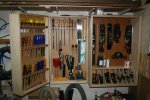- Messages
- 20,157
- Location
- Springfield, Missouri
I was watching DiResta's build of a tool cabinet and noticed his glue-up of the box joints only looked like he glued the vertical mating surfaces, not the fingers themselves. I'll admit, it makes for a fast assembly the way he shows (at 2:38 or so), but question the bond of the joints only being glued on 2 surfaces.
He does his videos in fast motion, so maybe he left out the glue-up of the fingers. Just curious if anyone else does them this way and how the joints hold up?
https://youtu.be/0wGAyzHRlfQ?t=159
He does his videos in fast motion, so maybe he left out the glue-up of the fingers. Just curious if anyone else does them this way and how the joints hold up?
https://youtu.be/0wGAyzHRlfQ?t=159



